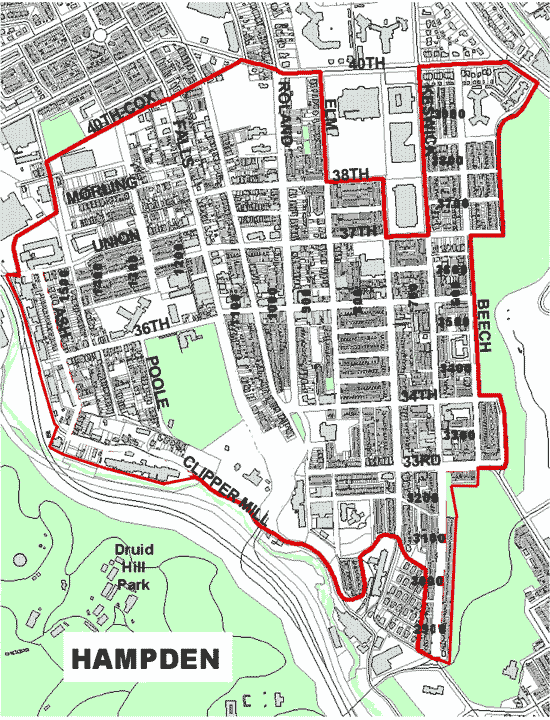Hampden
National Register of Historic Places 12/29/2004
Description
 The Hampden historic district is an approximately four hundred acre residential and commercial area initially created to support the industrial activities of the state's largest nineteenth century textile milling area. Generally bounded by the Jones Falls on the west and south, 40th Street on the North, and Wyman Park on the east, the community is distinguished by its sitting on various high ridges that overlook the Jones Falls Valley. Here, in the valley, a group of mill-owning families took advantage of the rushing waters of the Jones Falls to establish several neighboring mill villages beginning in the mid-1830s. Initially these mill owners provided housing near the mills for their workers and by the end of the Civil War several distinct villages had sprung up in the valley. Its early, surviving stone and frame mill housing, dating from the late 1830s to the mid-1860s distinguish this area of Hampden. In the 1970s development spread east to the crest of the hill, on Falls to Keswick Roads, where local developers put up single, paired, and rows of frame and brick housing. By the 1890s population increases led to the building out of the area with traditional city row house types. Building types also include commercial structures and churches.
The Hampden historic district is an approximately four hundred acre residential and commercial area initially created to support the industrial activities of the state's largest nineteenth century textile milling area. Generally bounded by the Jones Falls on the west and south, 40th Street on the North, and Wyman Park on the east, the community is distinguished by its sitting on various high ridges that overlook the Jones Falls Valley. Here, in the valley, a group of mill-owning families took advantage of the rushing waters of the Jones Falls to establish several neighboring mill villages beginning in the mid-1830s. Initially these mill owners provided housing near the mills for their workers and by the end of the Civil War several distinct villages had sprung up in the valley. Its early, surviving stone and frame mill housing, dating from the late 1830s to the mid-1860s distinguish this area of Hampden. In the 1970s development spread east to the crest of the hill, on Falls to Keswick Roads, where local developers put up single, paired, and rows of frame and brick housing. By the 1890s population increases led to the building out of the area with traditional city row house types. Building types also include commercial structures and churches.
Significance
The Hampden historic district is significant for providing a largely intact picture of the development of a self-sufficient working class community, based upon a single major industry, which flourished for nearly a century. Its mainly locally-built homes help provide an inventory of major types of vernacular, working class housing built in mid-nineteenth century America. In 1899 this relatively small geographical area produced more cotton duck than the combined output of any other milling centers in the United States. Examples of company built mill housing date from the late 1830s into the 1880s and offer an in-depth look at forms of worker house design that relate to early company towns elsewhere in the U.S.. Operating at their peak in the 1890s, the Hampden and Woodberry mills boasted some 4,000 employees. By this time company-built housing could no longer provide for the community's needs and a host of local builders and investors stepped forward to fill the void. By the later 1870s and the rapid expansion of mills, a variety of local builders and investors took over the job of supplying reasonably priced, practical, yet still stylish homes for the always growing number of mill workers. It was not really until the late 1890s that the blocks of Hampden located to the east of Falls Road began to fill up and that the commercial center of town, along 36th Street, began to take on an urban aspect. From this point on the development of Hampden followed urban models and was influenced by the stylistic forms of Baltimore City architecture.